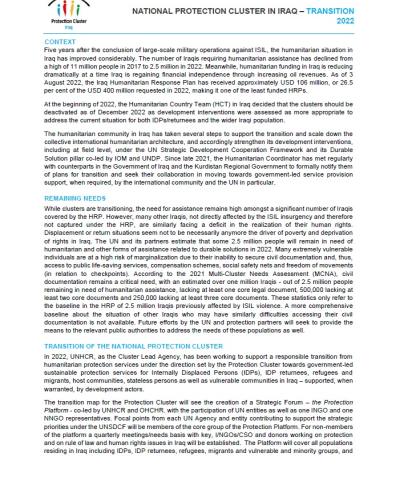NATIONAL PROTECTION CLUSTER IN IRAQ – TRANSITION 2022

CONTEXT
Five years after the conclusion of large-scale military operations against ISIL, the humanitarian situation in Iraq has improved considerably. The number of Iraqis requiring humanitarian assistance has declined from a high of 11 million people in 2017 to 2.5 million in 2022. Meanwhile, humanitarian funding in Iraq is reducing dramatically at a time Iraq is regaining financial independence through increasing oil revenues. As of 3 August 2022, the Iraq Humanitarian Response Plan has received approximately USD 106 million, or 26.5 per cent of the USD 400 million requested in 2022, making it one of the least funded HRPs.
At the beginning of 2022, the Humanitarian Country Team (HCT) in Iraq decided that the clusters should be deactivated as of December 2022 as development interventions were assessed as more appropriate to address the current situation for both IDPs/returnees and the wider Iraqi population.
The humanitarian community in Iraq has taken several steps to support the transition and scale down the collective international humanitarian architecture, and accordingly strengthen its development interventions, including at field level, under the UN Strategic Development Cooperation Framework and its Durable Solution pillar co-led by IOM and UNDP. Since late 2021, the Humanitarian Coordinator has met regularly with counterparts in the Government of Iraq and the Kurdistan Regional Government to formally notify them of plans for transition and seek their collaboration in moving towards government-led service provision support, when required, by the international community and the UN in particular.




